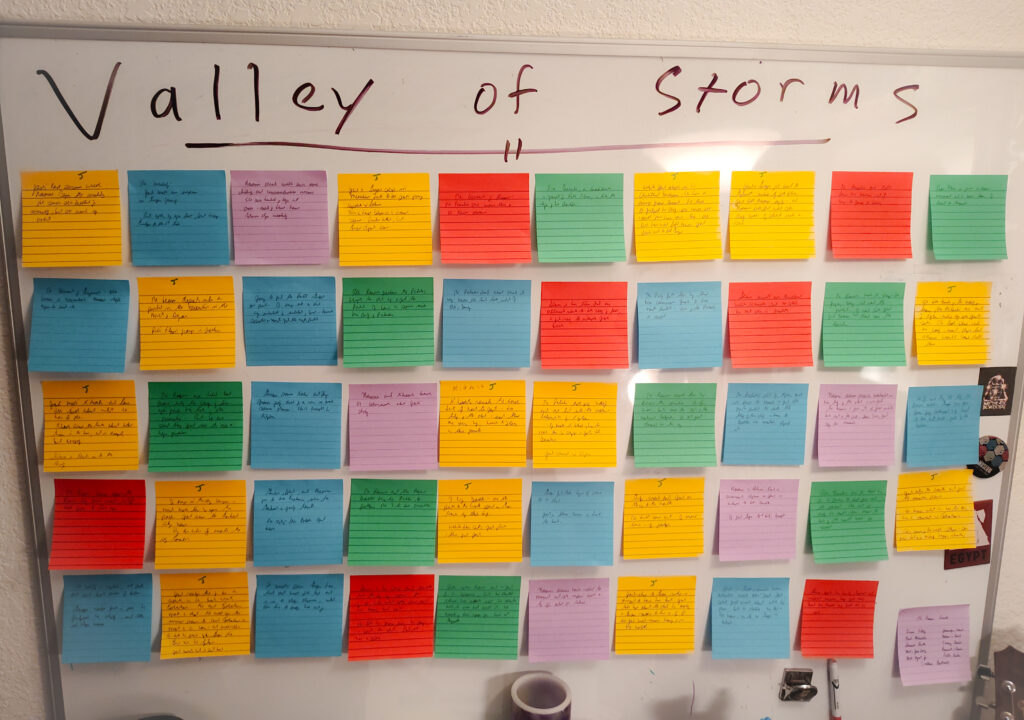
I often tell the story that I was unable to complete a book satisfactorily until 2019 when I first learned to plot. A lot of writers are allergic to this advice, thinking having a plot will kill their desire to write their story. This might be true for them, but there are also diverse levels of plotting, from detailed scene plans to a rough sketch of what you want to happen in your story. I am about 60% plotter, 40% pantser (or discovery writer). I have a main list of plot points and then kind of discover my way between them on a scene-by-scene level. But what do I mean by plot points, anyway? Is there a model that would help you construct that? I do have a strategy I use. There are many out there, this is just the one I’ve evolved that works best for me. I started with Dan Wells’ 7-point plot structure and tweaked it from there.
Every plot thread has nine main parts that I try to have a pretty good idea about. Here are the nine:
Opening – This establishes the status quo of the main characters at the start of the story. This is also where your story really begins. Some people add an exciting prologue to set the tone promises, but that is beyond the remit, and it is up to you whether or not you do that. The opening is the first part of the actual story, where you begin introducing your main characters and where they are in their lives.
Inciting Incident – Something happens that disrupts the protagonist’s status quo. This could also be a story goal being introduced. The story really gets started here, when the protagonist either starts working on the problem or must deal with whatever is happening to their lives.
Plot Point 1/Threshold 1 – T status of the story changes. There could be an escalation, a new venue introduced, but the story starts a different phase here. The protagonist’s life is much different now from when we met them in the opening.
Complication phase 1 – The problem gets worse, the goal gets further away, the protagonist’s solution blows up in their face, shit goes down. This can be a series of chapters or a series of scenes.
Midpoint – Probably the most important part of your story and should come as close to the middle of the book as possible. The Protagonist develops a new plan, another new venue is introduced, the antagonist’s attack, something major happens that turns the story in a new direction.
Complication Phase 2 – Just like complication phase 1, but more intense with higher stakes. The goals might seem further away, or they might seem impossible. There could be a development where the protagonist sees the glimmer of the plan, gathers their allies, etc. This gets, well, complicated. These things will be different based on the stakes of your book and your genre.
Plot Point 2/Threshold 2 – Sometimes called ‘the dark night of the soul,’ what happens here is dependent on your genre and stakes. In a romance, this is where the couple is separated, seemingly forever. But here the protagonist has been pushed to the breaking point. Maybe they’ve suffered a loss or an insurmountable setback. They have no clear plan and are left to gather the tools that are available to them and form a new one. They should also find some resolve here and this is where the stakes of the plot are underlined.
Climax – The main conflict comes to a head and is resolved in some way, whether in the protagonist’s favor or not. The ultimate battle, the reconciliation, the final overcoming of obstacles. In a mystery, this is where the villain is unmasked and confronted. This will be dependent on your genre and the conflicts that have been introduced. It looks vastly different depending on your genre.
Resolution – AKA the denouement, or the ‘marryin’ and buryin.’ The new status quo for the characters is established and, perhaps, explored. The newly established couples have a moment together, we mourn the characters who’ve died, the world has either returned to where it was in the opening, or the characters have entered a new phase of life.
I have cobbled these 9 points together from several different plot plans. None of this is really that original to me. But I don’t start drafting a book until I have these 9 points established. I can change things along the way, and often do, but if I have this firm of a plan, then I usually don’t write myself off a cliff the way I did before.
How this works for me is I plot out these nine points for each viewpoint character’s plotline. If I’ve done my job right, each plot thread has a different feel and a different set of stakes, but still fits within the whole. So, for my WIP where there are 5 different viewpoint characters, I did five plotlines and then braided them together into one outline. Yes, there were forty-five points on that plan. Still, while I know the big stuff, a lot of the scene by scene details I leave up to in-the-moment inspiration as for as how all of this develops and works out. Below is a picture of my plot board for the current WIP, with the plot points on post-it notes color coded by viewpoint character and plot thread.

So, that’s what I mean when I talk about being a plotter. This is what works for me, and it is a result of at least five years of iterating several different processes until I found something that clicked. I’ve written 12 books this way, and haven’t abandoned any books since I started doing this.
